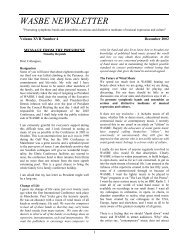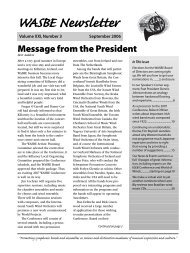March 2011 - World Association for Symphonic Bands and Ensembles
March 2011 - World Association for Symphonic Bands and Ensembles
March 2011 - World Association for Symphonic Bands and Ensembles
You also want an ePaper? Increase the reach of your titles
YUMPU automatically turns print PDFs into web optimized ePapers that Google loves.
phone – Bb cornet – 1 st & 2 nd Bb trumpets –<br />
3 rd & 4 th Bb trumpets – 1 st & 2 nd F French<br />
horns – 3 rd & 4 th F French horns – 1 st & 2 nd C<br />
trombones – 3 rd & 4 th C trombones – Bb<br />
Flugelhorn – Eb alto horn – Bb baritone horn<br />
– Bb euphonium – Eb bass – Bb bass – string<br />
bass – Timpani – 2 percussion (snare drum,<br />
bass drum, cymbals, castanets, tambourine,<br />
gong).<br />
CROQUIS SPORTIFS OPUS 85<br />
Although Absil had the <strong>Symphonic</strong> B<strong>and</strong><br />
of the Belgian Guides in mind <strong>for</strong> the<br />
majority of his compositions <strong>for</strong> <strong>Symphonic</strong><br />
B<strong>and</strong>, he did compose his second original<br />
Wind B<strong>and</strong> piece <strong>for</strong> an amateur Wind B<strong>and</strong>.<br />
Indeed, Absil had also connections with<br />
amateur Wind <strong>B<strong>and</strong>s</strong>. On November 21,<br />
1949, he attended a per<strong>for</strong>mance of his<br />
Flemish Rhapsody (cf. infra) by the<br />
Municipal B<strong>and</strong> of Roeselare (West-<br />
Fl<strong>and</strong>ers); the composer had lent the<br />
material to conductor Verdonck. In 1954,<br />
Georges Verdonck (1904 – 1970), conductor<br />
of the Municipal B<strong>and</strong> of Roeselare (West-<br />
Fl<strong>and</strong>ers) inquired whether Absil would<br />
accept to write a piece <strong>for</strong> the b<strong>and</strong> he was<br />
conducting. Absil generously complied with<br />
this request <strong>and</strong> thus the suite <strong>for</strong><br />
<strong>Symphonic</strong> B<strong>and</strong> Croquis Sportifs opus 85<br />
(Sports sketches) saw the light of day. The<br />
manuscript, with the separate parts in<br />
Verdonck’s h<strong>and</strong>writing, dates from 1955.<br />
score of “Croquis Sportifs”<br />
Georges Verdonck, conductor of the<br />
Roeselare Municipal B<strong>and</strong>, who commissioned<br />
“Croquis Sportifs”<br />
This suite was per<strong>for</strong>med at a concert <strong>for</strong><br />
Saint Cecilia’s holiday by the Roeselare<br />
Municipal B<strong>and</strong> on November 20, 1955. It<br />
consists of four parts. I. “Entrée des<br />
Athlètes” (The athletes’ entry) – a festive<br />
march; II. “Jeu des Athlètes” (The athletes’<br />
games) - a scherzo; III. “Les Baigneuses”<br />
(The swimming beauties) – a barcarole <strong>and</strong><br />
IV. “Cross Country” – a presto movement.<br />
Instrumentation:<br />
piccolo – flute – oboe<br />
– Eb clarinet – Bb solo<br />
clarinet – 1st, 2 nd & 3 rd<br />
Bb clarinets – Eb alto<br />
saxophone – Bb tenor<br />
saxophone – Eb<br />
baritone saxophone –<br />
1 st & 2 nd Bb cornet –<br />
1 st , 2 nd & 3 rd Bb<br />
trumpets – 1 st , 2 nd &<br />
3 rd F French horns –<br />
1 st , 2 nd & 3rd C<br />
trombones – Bb<br />
flugelhorn – Eb alto<br />
horn – Bb baritone<br />
horn – Bb euphonium<br />
– Eb bass – Bb bass –<br />
String bass – timpani<br />
– 3 percussion.<br />
LEGENDES D’APRÈS<br />
DVORAK OPUS 91<br />
In 1956, Absil<br />
turned again to the<br />
<strong>Symphonic</strong> B<strong>and</strong>. The<br />
renowned musicologist<br />
Ernest<br />
Closson 14 , considered<br />
as the godfather of<br />
the Belgian musicology, was teaching music<br />
history at the Etterbeek Academy of Music<br />
at that time <strong>and</strong>, someday, he drew Absil’s<br />
attention to a an album <strong>for</strong> piano fourh<strong>and</strong>ed<br />
entitled Légendes by Antonin<br />
Dvorak. Absil happened to come across this<br />
album again in 1956 <strong>and</strong>, notwithst<strong>and</strong>ing<br />
the popular character of this music, he<br />
decided to make a <strong>Symphonic</strong> B<strong>and</strong> orchestration.<br />
At least that was his initial intention,<br />
but he soon ab<strong>and</strong>oned this project as he<br />
found the piano part rich enough <strong>for</strong> this<br />
purpose. Actually, he only retained Dvorak’s<br />
tunes <strong>and</strong> composed a completely original<br />
Wind B<strong>and</strong> piece which he simply called<br />
Légendes pour harmonie d’après Dvorak<br />
opus 91 (Legends <strong>for</strong> <strong>Symphonic</strong> B<strong>and</strong><br />
after/according to Dvorak). The three part<br />
composition was premiered by the<br />
<strong>Symphonic</strong> B<strong>and</strong> of the Belgian Guides,<br />
conducted by Karel Torfs 15 at the I.N.R. radio<br />
concert hall in Brussels on October 7, 1957.<br />
FANFARE<br />
The short Fanfare pour les Jeunesses<br />
Musicales <strong>for</strong> brass ensemble was written<br />
<strong>for</strong> the opening ceremony of the 13 th <strong>World</strong><br />
Congress of the International Youth Musicians<br />
Federation at the Large Auditorium<br />
built <strong>for</strong> the 1958 <strong>World</strong> Fair in Brussels, on<br />
July 14, 1958. It was per<strong>for</strong>med by members<br />
of the National Orchestra of Belgium,<br />
conducted by André V<strong>and</strong>ernoot, next to<br />
similar short fanfares composed by Pieter<br />
Leemans 16 , Raymond Chevreuille 17 , Léon<br />
Jongen 18 <strong>and</strong> Vic Legley (cf. footnote 12).<br />
TROIS FANFARES (Three Fanfares)<br />
OPUS 118<br />
Here we have a piece <strong>for</strong> brass ensemble<br />
which was also dedicated to the Guides<br />
B<strong>and</strong>. In 1962, Yvon Ducène 19 , a <strong>for</strong>mer<br />
pupil of Absil, was appointed conductor of<br />
the prestigious Royal <strong>Symphonic</strong> B<strong>and</strong> of the<br />
Belgian Guides. Absil knew perfectly well<br />
that this was the right choice. In 1963, the<br />
pupil asked the Master to write a piece <strong>for</strong><br />
the b<strong>and</strong> <strong>and</strong> Absil wrote Trois Fanfares<br />
opus 118 <strong>for</strong> brass ensemble in three parts:<br />
1) Guerrière, 2) Funèbre <strong>and</strong> 3) Joyeuse<br />
(War Fanfare – Funeral Fanfare – Joyous<br />
Fanfare). These fanfares, written <strong>for</strong> 4<br />
trumpets, 4 cornets, 4 French horns, 2<br />
euphoniums, timpani <strong>and</strong> percussion, were<br />
premiered at a concert on the b<strong>and</strong>st<strong>and</strong> of<br />
the Royal Park in Brussels in 1963. Sometime<br />
later, Absil attended a concert of the<br />
Guides B<strong>and</strong> conducted by Ducène <strong>and</strong><br />
wrote in the b<strong>and</strong>’s guest book:<br />
“Je me joins de tout cœur au concert<br />
international de louanges qui s’adresse à<br />
la Musique des Guides. Cette admirable<br />
phalange se classe sans aucun doute en<br />
22 WASBE <strong>World</strong>


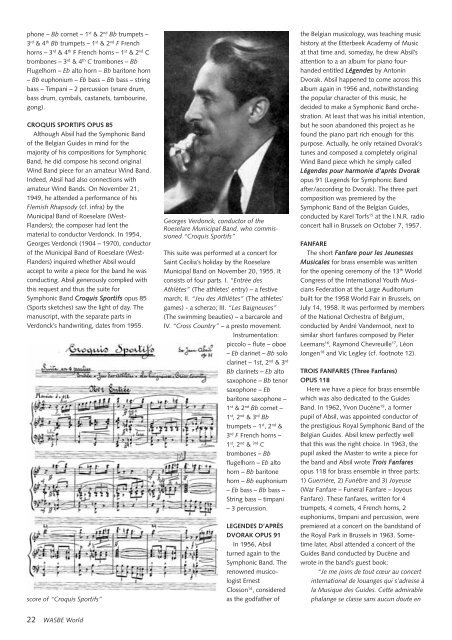
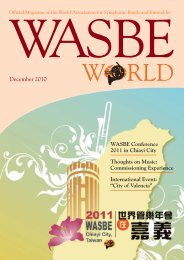
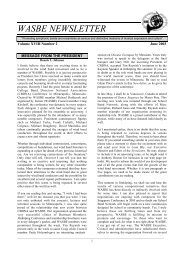

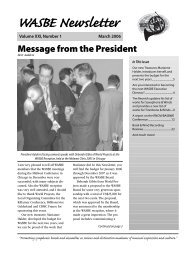
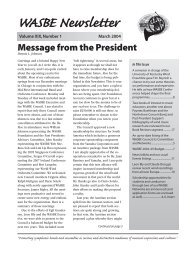

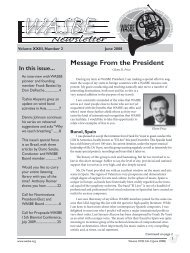
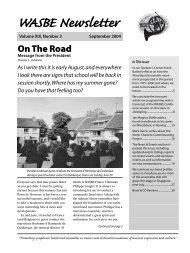
![application form [PDF; 110K]](https://img.yumpu.com/37266203/1/190x253/application-form-pdf-110k.jpg?quality=85)
